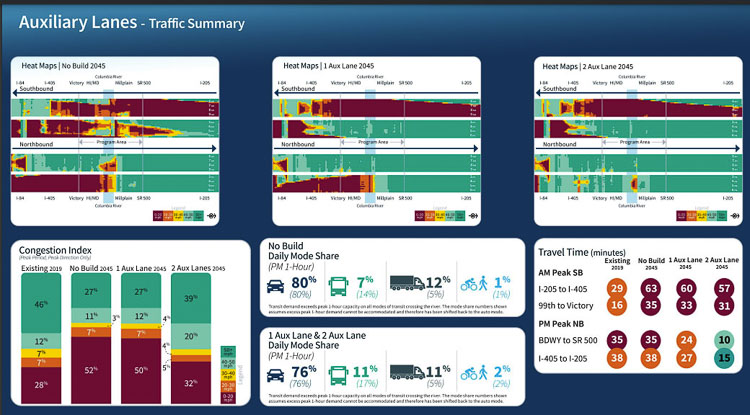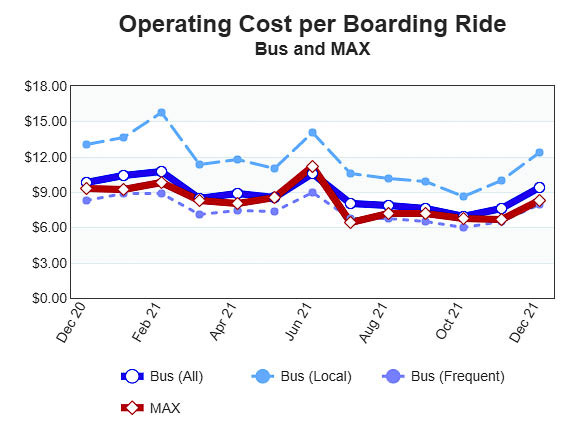TriMet and C-TRAN data show MAX costs 51 percent more than bus rapid transit
John Ley
For Clark County Today
At Tuesday’s meeting of the Southwest Washington Regional Transportation Council (RTC), staff provided an update on regional transportation data and issues. The key focus was a briefing by Frank Green, assistant program administrator of the Interstate Bridge Replacement Program (IBR). He shared the Modified Locally Preferred Alternative (LPA) will be revealed later this week.
The $1.1 billion in funding from Washington’s legislature was highlighted, setting the stage for the Oregon legislature to do likewise in its 2023 session. Light rail coming to Vancouver was highlighted as the transit component proposed by the IBR team. The final revelations to come will be the number of auxiliary lanes on the bridge, and the interchanges for access to Hayden Island.
Clark County Councilor Gary Medvigy chaired the meeting, serving as the RTC vice chairman this year. He pushed back on several key issues. “When do the people get to vote?” he asked.
“I’m concerned that the data does not support these changes,” he said. “How are we moving forward to really gauging what the public wants, instead of telling them what the engineers say they need?”
Clark County Councilor Gary Medivigy questions what the people want and what they are willing to pay for, at Tuesday’s RTC Board meeting. IBR’s Frank Green responds. Video courtesy CVTV
Medvigy noted that the Columbia River Crossing (CRC) failed for many reasons, including costs, light rail and tolling. He noted those items “ultimately caused the demise of the program.”
He mentioned that many people want a third bridge and transportation corridor. Medvigy spoke about a historic photo shown of the original 1917 bridge and that many people do not want that destroyed. “This existing bridge is an icon of the industrial era,” he said. “I wish we could preserve it because it’s a work of art representing that era, and it’s still standing.”
Medvigy said the early part of the IBR discussion spoke about a bridge that was “mass transit capable,” and suddenly, in spite of the huge decline in transit ridership, the IBR team is proposing light rail. “They could go down to Expo right now and make a connection with light rail as an option,” he said. He indicated there isn’t a need for high capacity transit right now.
Green told the RTC Board “there is high demand for cross river transit.” He said the acquisition costs were higher for light rail, but that operation and maintenance costs were lower for light rail.
He also said there was more demand for light rail transit versus bus rapid transit (BRT). Yet he had praised C-TRAN’s successful development of BRT, noting it will have three separate BRT lines completed by the time the bridge is done.
Currently, transit ridership accounts for 1.7 percent of I-5 cross river traffic, according to the IBR team. Administrator Greg Johnson has shared they expect a 10-fold increase in transit ridership by 2045 on the I-5 corridor. Yet, his team has failed to share that modeling data.
In discussing alignment options, whereas the previous CRC had light rail traveling on downtown Vancouver streets, Green noted that there had been a lot of development in downtown Vancouver. They desired to avoid negative impacts on those recently developed areas. The IBR team instead chose to run light rail along the I-5 corridor, with a terminus at Evergreen Blvd.
Medvigy had suggested running buses to Expo for the transfer and connection, given the current low demand for transit service. There is minimal “development” that would be negatively impacted with a transfer or connection point at the Expo Center, compared to either downtown Vancouver or Evergreen locations.
TriMet annual reports indicate the operating cost per boarding passenger for its MAX light rail service is $8.24. That is 51 percent higher than C-TRAN’s reported $5.44 BRT cost per passenger. How can the IBR claim light rail operating costs are lower? That certainly does not appear to be the case when comparing TriMet with C-TRAN. TriMet’s own “frequent bus service” is slightly cheaper than MAX light rail.

Green showed a “busy” slide of IBR team data for the corridor. The morning southbound commute time would go from 29 minutes to 57 or 60 minutes, when traveling from the I-205 interchange to the I-405 interchange in Portland. For those closer in, travel time would increase from 16 minutes to 31 or 33 minutes traveling from 99th St. to Victory Blvd.
“Transit demand exceeds peak 1-hour capacity on all modes of transit crossing the river:” states a footnote on Green’s slide. The IBR team projects doing nothing will cause transit ridership to increase 3-fold to 7 percent by 2045. If the project is built with either one or two auxiliary lanes, transit ridership will increase to 11 percent of I-5 trips across the river.
IBR data shows 28 percent of traffic is presently traveling zero to 20 mph in the evening, northbound direction of travel. After completion of the project, 32 percent will be traveling that slow if the project has two auxiliary lanes. If the project only has one auxiliary lane, 50 percent will be stuck in stop and go traffic. The “no build” scenario shows 52 percent traveling zero to 20 mph.
At best, this highlights the expenditure of up to $5 billion will not reduce stop-and-go traffic in the evening on the I-5 corridor. It will provide two minutes of improved time saved over the “no build” scenario, but traffic congestion will continue to get significantly worse.
The IBR’s modeling predicts people driving cars will decrease from 80 percent to 76 percent in 2045. The projections predict a three-fold increase (7 percent) in I-5 transit ridership in a “no-build” scenario, and 11 percent transit use if they build the project. It shows a 1 percent decline in trucks and freight using the corridor if the project isn’t built. Bike riders and pedestrian traffic increases from 1 to 2 percent.
During an April 7 meeting of the Executive Steering Group (ESG), Johnson said demand for transit on the I-5 corridor would increase 10-fold, to 26,000 to 33,000 boardings a day.
C-TRAN offers the only cross river transit service via its “express” bus service. Ridership had declined from 3,040 boardings in 2016 to 971 in 2020. The pandemic lockdowns caused C-TRAN to eliminate some of its express service and consolidate other lines. TriMet doesn’t expect transit ridership to return to pre pandemic levels for six years; just five years before the estimated projected completion.
“People want to vote on ‘what do we need; what do we want to pay for,’” Medvigy said. “Are we right back to all the bells and whistles” (of the CRC) he asked. “How are we moving forward to gauge what the public wants?” he asked in conclusion.
Green cited all the communication and surveys the IBR team has done, saying the interest “leans toward light rail.” He cited the Community Advisory Group and Equity Advisory Group making input, in addition to community surveys.
Yet those same community surveys report that 7 of 10 respondents want reduced traffic congestion. Southwest Washington residents have told the IBR team that 78 percent want congestion relief. People in both states want to save time in their travels, which the project will apparently fail to deliver.
TriMet has a history of broken promises, when it comes to light rail. It appears to be short 50,000 boardings for the two newest light rail lines, when compared to the optimistic ridership projections.

RTC Director Matt Ransom closed out the meeting by summarizing “next steps.” He noted he will be asked to allow the project to proceed later this week when more details are revealed to the Executive Steering Group on Thursday. He painted a picture of “continuing to the next level of study” rather than a full up or down vote on the project. None of the RTC Board members objected.
On Friday, the 16 legislators of the Bi-state Bridge Committee will also meet to get the latest update with likely details on Hayden Island interchanges and the number of auxiliary lanes.




